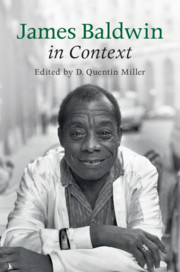Book contents
- James Baldwin in Context
- James Baldwin in Context
- Copyright page
- Contents
- Contributors
- Introduction: James Baldwin in Context
- Part 1 Life and Afterlife
- Part 2 Social and Cultural Contexts
- Part 3 Literary Contexts
- Chapter 19 The Protest Essay Tradition
- Chapter 20 Baldwin and the Black Arts Movement
- Chapter 21 Baldwin and the Rhetoric of Confession
- Chapter 22 The Poetics of Beautiful Blackness On Baldwin and Négritude
- Chapter 23 Mid-Century Theater
- Chapter 24 Sex and the Twentieth-Century Novel
- Chapter 25 Responding to Richard Wright
- Chapter 26 Baldwin’s Literary Friendships
- Chapter 27 Reviewers, Critics, and Cranks
- Chapter 28 Baldwin’s Collaborative Dance
- Chapter 29 Baldwin’s Literary Progeny
- Index
Chapter 26 - Baldwin’s Literary Friendships
from Part 3 - Literary Contexts
Published online by Cambridge University Press: 12 July 2019
- James Baldwin in Context
- James Baldwin in Context
- Copyright page
- Contents
- Contributors
- Introduction: James Baldwin in Context
- Part 1 Life and Afterlife
- Part 2 Social and Cultural Contexts
- Part 3 Literary Contexts
- Chapter 19 The Protest Essay Tradition
- Chapter 20 Baldwin and the Black Arts Movement
- Chapter 21 Baldwin and the Rhetoric of Confession
- Chapter 22 The Poetics of Beautiful Blackness On Baldwin and Négritude
- Chapter 23 Mid-Century Theater
- Chapter 24 Sex and the Twentieth-Century Novel
- Chapter 25 Responding to Richard Wright
- Chapter 26 Baldwin’s Literary Friendships
- Chapter 27 Reviewers, Critics, and Cranks
- Chapter 28 Baldwin’s Collaborative Dance
- Chapter 29 Baldwin’s Literary Progeny
- Index
Summary
A broad, interracial circle of family, friends, and collaborators animated James Baldwin’s life and work, radically revising the contours of what we understand to be “literary friendship” in the twentieth century. His friendships with others were characterized by a deep generosity of spirit; he often lent his time, money, and boundless energy to the creative and vocational pursuits of his closest friends and was rewarded with similar demonstrations of generosity in return. For Baldwin, friendship was not simply an amicable and reciprocal bond of identification between admirers: if you were a friend of Jimmy’s, you were kin. Growing up the oldest of nine children in 1930s Depression-era Harlem, Baldwin often took care of his brothers and sisters – changing diapers, bathing and taking them on walks through the neighborhood, known by locals as the “Hollow.” Baldwin’s friendship practices therefore mirrored the patient and unending acts of love, duty, and care that were integral to his experience as an eldest brother. In his biography of Baldwin, David Leeming shares a meaningful anecdote that illustrates Baldwin’s unique vision of friendship, where in a debate with a well-known sociologist about the restrictive categorization of the term “sibling,” Baldwin clapped hands on the arms of both his brother David Baldwin and his friend David Leeming and yelled “These are my brothers; not my siblings, motherfucker!” Thus, when Amiri Baraka writes in his eulogy for James Baldwin that “As man he was Our friend, Our older or younger brother,” he does more than speak political rhetoric; he celebrates the powerful forces of adoption that were so central to Baldwin’s life and work.
- Type
- Chapter
- Information
- James Baldwin in Context , pp. 276 - 286Publisher: Cambridge University PressPrint publication year: 2019



